Early maturing table potato variety Vega
Vega potatoes produce a rich harvest even in short summer conditions. The variety is resistant to a number of diseases dangerous to the nightshade family and quickly adapts to sudden temperature changes. The crop does not require the use of complex agricultural techniques, and its taste always meets the expectations of gardeners.
What kind of potatoes are these?
The Vega potato variety belongs to the table type and is distinguished by early ripening and high fruiting rates.
Origin and development
The birthplace of the Vega potato is Germany. German specialists worked hard to create a new crop, resulting in a high-yielding and early-ripening variety, which over time gained popularity not only in the West, but also in Russia, Belarus and Ukraine.
The culture was included in the State Register of the Russian Federation in 2013. Despite its short lifespan, the variety is known to many gardeners in all regions.
This is interesting! Due to the potato's worldwide fame and invaluable contribution to the food industry, a Museum dedicated to this vegetable has been opened in Belgium. It contains many exhibits, including paintings by famous artists.
Distinctive features, characteristics of the variety
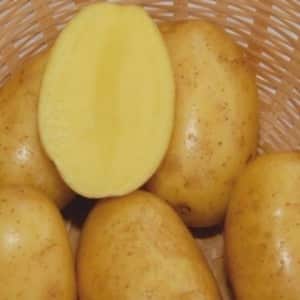 The average weight of ripe root vegetables is 90-130 g, oval shape. The peel is light yellow with barely noticeable small eyes. The thickness of the skin is average, it is quite durable, so vegetables have increased shelf life. Harvest safety is up to 99% of the total mass.
The average weight of ripe root vegetables is 90-130 g, oval shape. The peel is light yellow with barely noticeable small eyes. The thickness of the skin is average, it is quite durable, so vegetables have increased shelf life. Harvest safety is up to 99% of the total mass.
The pulp is light in color, closer to lemon, which does not darken during heat treatment. The taste quality is high, making potatoes suitable for preparing any dish, as well as chips, frozen vegetable mixtures and fast foods.
Purpose of ripe vegetables for table use. The starch content ranges from 10-15%. Its formation is influenced by soil composition. The more nutritious the soil, the higher the starch content.
Description of the plant
Medium height bush, erect. The leaves are rich green, medium-sized, moderate foliage. When flowering, neat white flowers with a cream tint are formed.
Culture resistant to long-term drought and perfectly adapts to short-term cold snaps. The ripening period is early, harvesting begins 60-70 days after planting.
Plants are endowed with stable immunity to potato cancer, golden nematode and potato mosaic virus. But the crop has average resistance to late blight.
About other potato varieties:
Unpretentious and highly productive El Mundo potatoes
Productivity
Vega Potatoes ideal for industrial breeding and is in demand among farmers-entrepreneurs. The average yield is 250-300 c/ha. But with proper care and fertile soil, the indicators increase to 450 c/ha.
At least 8 large potatoes are formed on 1 seedling. All root vegetables are almost the same size, aligned.
How to grow potatoes
The quality of finished products is influenced not only by proper care during the growing season, but also pre-sowing treatment of seed material.If you follow the necessary and simple rules, a rich and tasty harvest is guaranteed.
Pre-sowing preparation
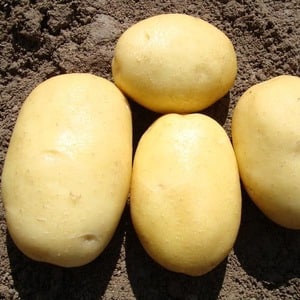 Tubers weighing no more than 100 g are selected for planting material. (the size of a chicken egg). They are carefully examined and only healthy ones are left, without visible damage and unchanged in color.
Tubers weighing no more than 100 g are selected for planting material. (the size of a chicken egg). They are carefully examined and only healthy ones are left, without visible damage and unchanged in color.
Tuber preparation begins 1 month before sowing in the ground. Selected potatoes are laid out in a bright room for germination. The temperature is maintained at +15°C. Within a month, the sprouts on the tubers grow to 1.5-2 cm.
Directly Before planting, the seed is processed a weak solution of potassium permanganate or the drug “Fitosporin” for disinfection purposes.
Reference! To increase immunity, 1 week before sowing, potatoes are taken outside for 1 hour. This procedure is called hardening and helps to strengthen the immunity of plants and more quickly adapt to outdoor conditions.
Timing, scheme and technology of planting
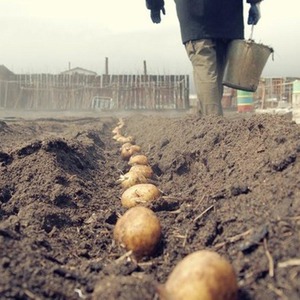 They begin to plant in the ground in late April or early May.. The final dates will be determined by the climatic conditions of the region. The daytime air temperature should remain at +17…+19°C, and the minimum soil temperature +9°C.
They begin to plant in the ground in late April or early May.. The final dates will be determined by the climatic conditions of the region. The daytime air temperature should remain at +17…+19°C, and the minimum soil temperature +9°C.
The soil is chosen to be light and fertile. For lightness, river sand or peat is added to it.
The soil is prepared in the fall, dug up and humus and wood ash are added for fertility.
Planting scheme: 35 cm – distance between seedlings, 70 cm is left between rows. The depth of the holes is no more than 15 cm. A little wood ash is placed at the bottom of each and filled with water. After planting, the tubers are covered with soil and slightly moistened.
Reference! Many gardeners focus on birch leaves.As soon as the first leaves bloom, you can start planting.
Further care
Caring for the variety does not involve any complex procedures. All agricultural practices come down to standard cultivation rules, namely: watering, loosening, weeding and hilling.
The main thing is to maintain the regime and avoid excess or lack of moisture. Although the crop is adapted to long-term drought, you should not abuse this feature if you want to get tasty, marketable tubers.
Watering
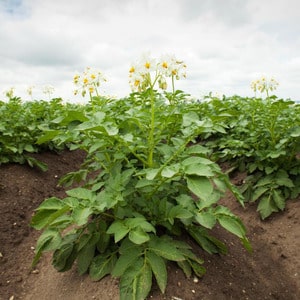
Plantings are watered for the first time when the seedlings reach a height of 10 cm. Before this, irrigate only when the soil is very dry. In the future, water infrequently, but abundantly. Be sure to control the humidity level in the beds. This is especially important for all plants susceptible to fungal diseases.
After watering, loosening is carried out. Access to oxygen to the root system is necessary for the full growth of bushes and strengthening their immunity. During loosening, weeding is carried out, removing all weeds with roots so that they do not interfere with the healthy growth of seedlings.
Advice! The use of drip irrigation eliminates increased levels of humidity in the beds: water is supplied exclusively to the roots of the seedlings and does not stagnate in the soil.
Hilling is no less important than watering or loosening. Promotes the formation of new roots, which has a beneficial effect on fruiting. Plants are hilled three times a season, raking the soil from the rows onto the bushes with a hoe. In addition, hilling protects the tubers from exposure to sunlight.
Feeding
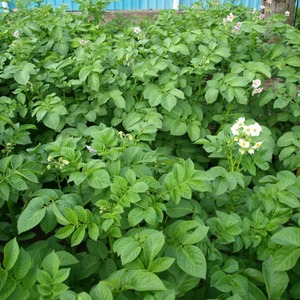 Seedlings are fed at least 2 times per season. During the growth and formation of root crops, organic compounds, such as urea, are used as fertilizers.
Seedlings are fed at least 2 times per season. During the growth and formation of root crops, organic compounds, such as urea, are used as fertilizers.
During the flowering period and at the time of fruiting the crop is fertilized with a complete mineral complex with a predominant content of potassium and phosphorus.
If the bushes grow poorly after transplantation use nitrogenous substances that help plants grow green mass.
Reference! Any fertilizing is applied after abundant watering.
Disease and pest control
Late blight is the most serious disease for nightshade crops., difficult to treat. Compliance with planting technology and pre-sowing treatment is a mandatory and important preventive measure.
With a sufficient distance from each other, the seedlings will be ventilated and receive the required amount of light. With moderate watering, the humidity level will not be exceeded, which means the risk of developing fungal spores will be reduced.
Another important and necessary measure in the fight against late blight – compliance with crop rotation rules. Potatoes are not planted in the same beds where peppers, eggplants and tomatoes used to grow. The best predecessors are greens and legumes. After them, the soil retains fertility, being saturated with nitrogen.
When preventing fungal diseases, do not forget about insect pests, from which seedlings suffer no less than from diseases:
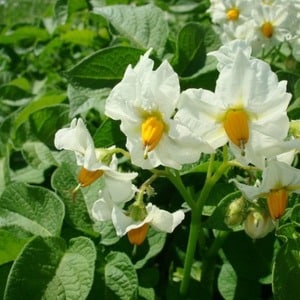 Colorado beetle capable of destroying plantings in a few days. In addition to adults, larvae are dangerous for plants. When inspecting bushes, it is important to turn over the leaves, otherwise the larvae will go unnoticed. In case of mass damage, the insecticide “Prestige” is used. If the quantity is small, the beetle and larvae are collected by hand.
Colorado beetle capable of destroying plantings in a few days. In addition to adults, larvae are dangerous for plants. When inspecting bushes, it is important to turn over the leaves, otherwise the larvae will go unnoticed. In case of mass damage, the insecticide “Prestige” is used. If the quantity is small, the beetle and larvae are collected by hand.- Wireworm lives in the soil and attacks root crops, which subsequently rot in the ground. Digging the soil in the fall and before spring planting is an effective preventive measure in the fight against the pest. Also, the wireworm does not tolerate mustard, so when planting tubers, it is enough to pour a little mustard powder into the holes.
Read also:
Collection, storage and use of crops
The crop is dug up with a shovel or pitchfork. Thick skin reduces the risk of mechanical damage to root crops. Dig potatoes as soon as the foliage begins to fade. After harvesting, the tubers are laid out to dry in the sun for several hours.
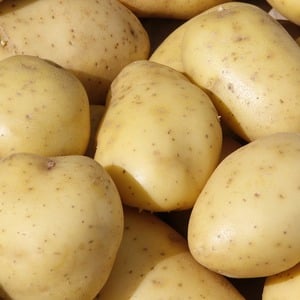 Before storing vegetables for long-term storage, they are carefully inspected, damaged ones are disposed of. Potatoes are placed in wooden boxes and left in a cool, dry room.
Before storing vegetables for long-term storage, they are carefully inspected, damaged ones are disposed of. Potatoes are placed in wooden boxes and left in a cool, dry room.
Vega has high keeping quality, so the tubers retain their presentation and taste until spring. Long-term transportation also does not affect the safety of the finished product.
Ripe vegetables have a universal purpose and used not only in private households, but also in large industries. They are used to prepare chips, semi-finished products and fast food. Potatoes are also readily purchased by restaurant chains. In households, all kinds of dishes are prepared from Vega, which are distinguished by their rich taste and pleasant color.
Advantages and disadvantages
Vega potato variety has significant advantages:
- high fruiting rate;
- possibility of breeding for sale;
- drought resistance;
- adaptation to cold weather;
- early ripeness;
- excellent taste;
- long-term preservation;
- long transportations.
The disadvantages include susceptibility to late blight. But if the necessary preventive measures are taken, the crop is not prone to disease.
For which regions is it best suited?
Vega bred not only throughout Russia, it has taken root well in Ukraine and Belarus. The variety shows high productivity in all regions, although the central part of the Russian Federation is considered the most suitable in terms of climate and soil composition.
Farmer reviews
Gardeners view Vega only from its positive sides. Here are the opinions of some farmers:
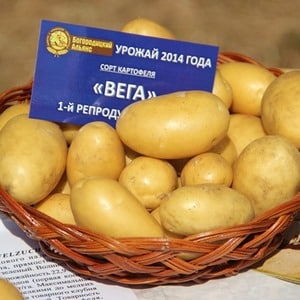 Vladimir, Moscow: “I thought for a long time about what kind of potatoes to plant, and chose Vega - I liked the description and photo of the variety. What can I say about her? The growing season passed easily, the seedlings did not get sick, they stood straight and beautiful. I collected a lot of tubers, watered them infrequently, but abundantly, and did not let the soil dry out. The vegetables are tasty, do not crumble when cooked, and retain their color when fried. Potatoes go well with mayonnaise, so they can be added to any salad.".
Vladimir, Moscow: “I thought for a long time about what kind of potatoes to plant, and chose Vega - I liked the description and photo of the variety. What can I say about her? The growing season passed easily, the seedlings did not get sick, they stood straight and beautiful. I collected a lot of tubers, watered them infrequently, but abundantly, and did not let the soil dry out. The vegetables are tasty, do not crumble when cooked, and retain their color when fried. Potatoes go well with mayonnaise, so they can be added to any salad.".
Ekaterina, Minsk: “The variety requires a lot of water, it needs to be watered abundantly. If there is a lack of moisture, the tubers become much smaller, but their taste properties are not lost. You can cook whatever your heart desires from vegetables. I like these potatoes best in borscht and stew with other vegetables. Caring for Vega is not difficult, the bushes do not get sick, but I initially protect them from late blight.”.
Conclusion
Vega potatoes do not belong to domestic developments. But this did not stop him from filling many Russian beds. The crop has a high fruiting rate, reaching up to 450 c/ha, is resistant to drought and short-term cold snaps, is immune to many dangerous diseases and has increased shelf life.Almost the entire harvest is stored until spring, without losing its nutritional value and presentation.